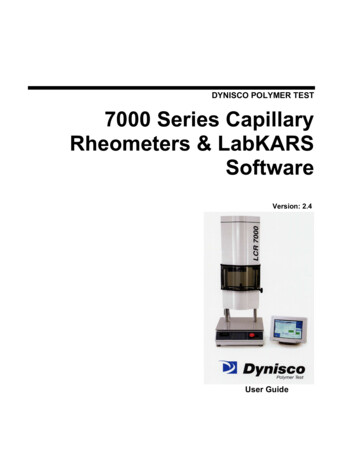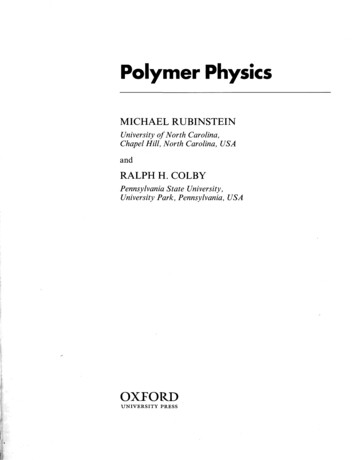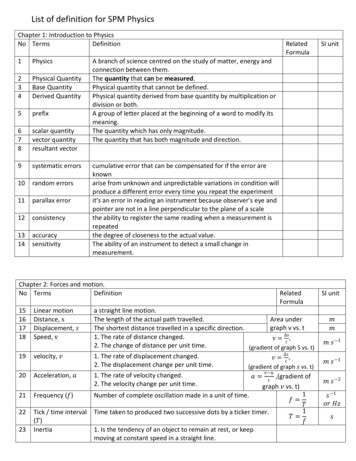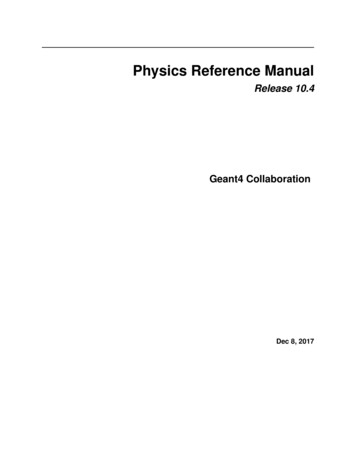
Transcription
Introduction to polymer physicsLecture 1Boulder Summer SchoolJuly – August 3, 2012A.GrosbergNew York University
Lecture 1: Ideal chains Course outline:Ideal chains (Grosberg)Real chains (Rubinstein)Solutions (Rubinstein)Methods (Grosberg)Closely connected:interactions (Pincus),polyelectrolytes(Rubinstein) , networks(Rabin) , biopolymers(Grosberg), semiflexiblepolymers (MacKintosh) This lecture outline: Polymers and theiruses Scales Architecture Polymer size andfractality Entropic elasticity Elasticity at highforces Limits of ideal chain
Polymer molecule is a chain: Polymeric from Greek polymerēs having many parts;First Known Use: 1866(Merriam-Webster);Polymer molecule consistsof many elementary units,called monomers;Monomers – structuralunits connected by covalentbonds to form polymer;N number of monomers in apolymer, degree ofpolymerization;M N*mmonomer molecularmass.Examples: polyethylene (a), polysterene(b), polyvinyl chloride (c) and DNA
Another view:
Scales: kBT 4.1 pN*nm atroom temperature(240C) Breaking covalentbond: 10000 K;bonds are NOT inequilibrium. “Bending” and noncovalent bondscompete with kBT Monomer size b Å; Monomer mass m –from 14 to ca 1000; Polymerizationdegree N 10 to 109; Contour lengthL 10 nm to 1 m.
Polymers in materials science(e.g., alkane hydrocarbons –(CH2)-)# Catoms1-56-1516-2520-501000 ormore@ 25oCand 1atmGasLowviscosityliquidVeryviscousliquidSoft solid ToughsolidUsesGaseousfuelsLiquidfuels andsolventsOils andgreasesCandlesandcoatingsBottles ExamplesPropaneGasolineMotor oilParaffinwaxPolyethylene
Polymers in living natureDNARNAProteinsLipidsPolysaccharidesNUp to 101010 to 100020 to 10005 to 100giganticNicephysicsmodelsBioinformatics,elastic rod,charged funnels, ratchets,active brushesBilayers,liposomes,membranes? Someonehas to startUsesMolecule
Polymer properties depend on Chemical composition of a monomer;Degree of polymerization, N;Flexibility;Architecture;Homopolymerversus heteropolymer.heteroHomo
Architecture
Architecture cont’d
Homo- vs. HeteroHomopolymer consists of monomers of just one sort:Heteropolymer (copolymer) has two or more monomer blocktriblockmultiblock
Flexibility Sufficiently long polymer is neverstraight Different polymers bend differently:
Rotation isomers:Polyethylene: bond length l 1.54A, tetrahedral angle θ 68oφiHθiHHCi 1 Hyi 1HCiyi θi-1HCi-1HHyi-1HHHHC HCCHHHH CHHHCtrans φi 0HCHHCCgauche φi 2π/3HCi-2Torsion (measured in angle φ)main source of polymer flexibility.Δε kBTgaucheΔεgauchetransΔE
Elastic flexibility: Within one rotamer, ΔE φ2 – Hook’s law. Many polymers have no freedom to explorerotational isomers, e.g., two strands. Elastic rod model:
How much is polymer bent? How much is polymerbent? What is its size R,given N? Can we measure it? How/why is itimportant? How does it depend onconditions, e.g.,temperature?
Polymer SizeMonomer size b 0.1nm; Number of monomers N 102-1010;Contour length L 10nm – 1m;Depending on how much polymer is bent,its overall size R varies widely and depends on solvent qualityLong-range repulsion Good solventR 1mR 100mmθ-solventR 10mmPoor solventR 100nm
Astronomical Variations of Polymer SizeIncrease monomer size by a factor of 108: b 1cm; let N 1010.Poor solventGood solventθ-solventLong-range repulsion
Ideal polymer vs. ideal gas StrongStrong dependencedependence ofof polymerpolymersizeonenvironment/solventsize on environment/solventconditionsconditions suggestssuggests aa bigbig rolerole ofofinteractions.interactions. IdealIdeal polymerpolymer hashas nono een monomers, exceptbetweenbetween neighborsneighbors alongalong thethechain.chain. JustJust likelike idealideal gasgas maymay havehave allallsortsofrotationsandvibrationssorts of rotations and vibrationsinin thethe molecule,molecule, butbut nonointeractionsbetweeninteractions between molecules.molecules. LikeLike idealideal gasgas isis thethe mostmost usefulusefulidealizationinstatisticalidealization in statisticalmechanics,mechanics, soso isis thethe idealidealpolymer.polymer. IdealIdeal chainschains areare goodgood modelsmodels forforpolymermelts,concentratedpolymer melts, concentratedsolutions,solutions, andand dilutedilute solutionssolutions atatθ-temperatureθ-temperatureno interactions, thechain “does not see”itself
Ideal chain sizeIdeal chain: no interactionsbetween monomers if they are notneighbors along the chain, even ifthey approach one another in space.Conformation of anideal chain is fullyspecified by the setof bond vectors {yi}
Ideal chain size: mean squared end-toend distanceIdeal chain: no interactionsbetween monomers if they are notneighbors along the chain, even ifthey approach one another in space.Conformation of anideal chain is fullyspecified by the setof bond vectors {yi}Freely-jointed chain or lattice model:
Ideal chain size: mean squared end-toend distanceFor ideal chains, onecan show that thereare no long-rangecorrelations betweenbond directions:For example, freely-rotating chain:SpecificSpecific flexibilityflexibility mechanismmechanism (rotational(rotational isomersisomers etc)etc)isis hiddenhidden inin characteristiccharacteristic ratioratio CC anicsMechanicsofofChainChainMoleculesMolecules
Ideal chain size: worm-like chain(Kratky and Porod model)Key argument:
Universal description of ideal polymerConstruct equivalent freely jointed chain with the same mean squared endto-end distance R2 and the same contour length L as actual polymer. Itconsists of N effective, or Kuhn, segments, each of length b, such that:For chain of n bonds oflength l each:Worm-like chain, totallength L, persistence l:Kuhn length and #ofeffective segments areKuhn length and #ofeffective segments areEquivalent freely jointed chain differs from the actual polymer onlength scales of Kuhn segment b or smaller, but has the samephysical properties on large scales
Reverse the question ofpolymer size:how many monomers are there within radius r? If r is greater thanKuhn segment, r b,then sub-coil of gmonomers has sizeR(g) g1/2b; Therefore, withinradius r we expectm(r) (r/b)2monomers.r
Counting “atoms” in regular objectsm r3for 3D objectm r2for 2D objectm r1for 1D object3D2D1D30D
Koch curve: example of a fractalr2m rdfr1df – fractal dimensionWe can either increase “observation field” r, ordecrease the size of elementary “atom”
Polymeric fractalsFor ideal chain, m(r) (r/b)2;that means, ideal polymer hasfractal dimension df 2.Scaling exponent ν 1/df 1/2for ideal polymer.We will see later that in a goodsolvent df 5/3 and ν 3/5IdealIdeal coilcoil cancan bebe viewedviewed asas N/gN/gblobsblobs ofof gg segmentssegments each.each. BlobBlob1/2sizesize isis x bgx bg1/2,, thereforetherefore1/21/21/2R bN x(N/g)R bN x(N/g)1/2Problem:Problem consider polymer adsorbed on a 2D plane. What are theconsequences of the fact that df D?
Radius of gyrationEnd-to-end distance is difficult to measure (and it is illdefined for, e.g., rings or branched polymers). Betterquantity is gyration radius:Where position vector of mass center isThere is theorem (due to nobody lesser than Lagrange)which says thatExercises: (1) Prove Lagrange theorem; (2) Provethat for ideal linear chain Rg2 Nb2/6; (3) Prove thatfor ideal ring Rg2 Nb2/12
Entropic elasticityOptical tweezersexperimentHow much forceshould we apply toachieve end-to-enddistance R?
Pincus blob argumentGauss distribution of R followsdirectly from Central Limit Theorem
What if we pull harder?Gaussiantheory issatisfactoryonly up toabout 0.1pNS. Smith, L. Finzi, C. Bustamante, \Direct Mechanical Measurements of the Elasticity ofSingle DNA Molecules by using Magnetic Beads", Science, v. 258, n. 5085, p. 1122, 1992.
Non-universal elasticity athigher forces
From Langevin to Marko-Siggia Exact formula forfreely-jointedchain: Very accurateformula for wormlike chain:whereCompare: Einstein and Debye theories of heat capacityof a solid
Chains Get Softer Under TensionLineardeformationregimef (1-Rf/Rmax)-2f (1-Rf/Rmax)-1 KNonlinearsemi-flexibleNonlinear flexible K-1bending constant KLinear deformation regime ends at f kBT /b.Problem: Why is there a cross-over from semi-flexible (worm-like) chain toflexible (freely-jointed) chain with increasing tension at fc kBT K/l ?
Pair Correlations of an Ideal ChainrNumber of monomers withinrange rr m b Probability of finding a monomerat a distance r from a given oneg (r ) 2m1 r 3 rb 2Pair correlation function for a D-dimensionalmfractal with m r Dg ( r ) 3 r D 3r
Scattering provides ensembleaverage information over widerange of scalesLight ScatteringAlan Hurd
Summary of Ideal Chains No interactions except along the chainEquivalent Kuhn chain22R NbMean square end-to-end:NbR Mean squared gyration radius:6r 3 3R P (N , R ) exp Probability distribution: 2πNb 2Nbr 3RFree energy: F 2 kT Nbr 3kT rfEntropic “Hook’s Law”: Nb R3 1g(r) Pair correlation function:π rbNonlinear elasticity at high forces22g3/ 23d2222222
Mayer f-functionU(r)rEffective interactions potential between twomonomers in a solution of other molecules.Relative probability of findingtwo monomers at distance r2exp(-U/kT)1Mayer f-function0U (r ) f (r ) exp 1 kT Excluded volumer 3v f (r )d rf11.510.50-0.5-112r/b323r/b44
Classification of Solventsr 3v f (r )d rAthermal, high Tb rfGood solvent, repulsion dominatesv b30 v b3rfrfθ-solvent, repulsion compensatesattractionPoor solvent, attraction dominatesfrv 0v 0Typically, but not always, repulsion dominates at higher, andattraction -- at lower temperatures.
Pair interaction dominance: In ideal coil, R bN1/2. Monomer volumefraction φ Nb3/R3 N-1/2 1 The number of pair contacts Nφ N1/2 1;pair collisions are important. The number of triple contacts Nφ2 1; theybecome important only if chain collapses. Higher order are unimportant unless strongcollapse.
interactions between molecules. Like ideal gas is the most useful idealization in statistical mechanics, so is the ideal polymer. Ideal chains are good models for polymer melts, concentrated solutions, and dilute solutions at θ-temperature Strong dependence of polymer size










